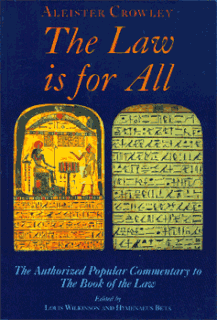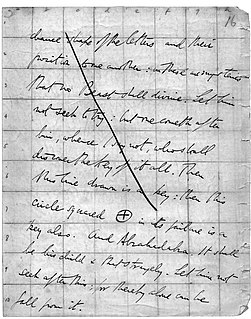
Thelema is an esoteric and occult social or spiritual philosophy and new religious movement developed in the early 1900s by Aleister Crowley, an English writer, mystic, and ceremonial magician. The word thelema is the English transliteration of the Koine Greek noun θέλημα, "will," from the verb θέλω (thélō): "to will, wish, want or purpose."

Liber AL vel Legis, commonly known as The Book of the Law, is the central sacred text of Thelema. Aleister Crowley said that it was dictated to him by a beyond-human being calling himself Aiwass. Rose Edith Kelly, Crowley's wife, wrote two phrases in the manuscript. The three chapters of the book are spoken by the deities Nuit, Hadit, and Ra-Hoor-Khuit.
Aleister Crowley, the founder of Thelema, designated his works as belonging to one of several classes. Not all of his work was placed in a class by him.

Ceremonial magic encompasses a wide variety of rituals of magic. The works included are characterized by ceremony and numerous requisite accessories to aid the practitioner. It can be seen as an extension of ritual magic, and in most cases synonymous with it. Popularized by the Hermetic Order of the Golden Dawn, it draws on such schools of philosophical and occult thought as Hermetic Qabalah, Enochian magic, Thelema, and the magic of various grimoires. Ceremonial magic is part of Hermeticism and Western esotericism.
Aleister Crowley wrote The Gnostic Mass — technically called Liber XV or "Book 15" — in 1913 while travelling in Moscow, Russia. The structure is similar to the Mass of the Eastern Orthodox Church and Roman Catholic Church, communicating the principles of Crowley's Thelema. It is the central rite of Ordo Templi Orientis and its ecclesiastical arm, Ecclesia Gnostica Catholica.
True Will is a term found within the mystical system of Thelema. It is defined either as a person's grand destiny in life or as a moment-to-moment path of action that operates in perfect harmony with nature. True Will does not spring from conscious intent, but from the interplay between the deepest self and the entire universe. Thelemites in touch with their True Will are said to have eliminated or bypassed their false desires, conflicts, and habits, and accessed their connection with the divine. Theoretically, at this point, the Thelemite acts in alignment with nature, just as a stream flows downhill, with neither resistance nor "lust of result".
Abrahadabra is a word that first publicly appeared in The Book of the Law (1904), the central sacred text of Thelema. Its author, Aleister Crowley, described it as "the Word of the Aeon, which signifieth The Great Work accomplished." This is in reference to his belief that the writing of Liber Legis heralded a new Aeon for mankind that was ruled by the god Ra-Hoor-Khuit. Abrahadabra is, therefore, the "magical formula" of this new age. It is not to be confused with the Word of the Law of the Aeon, which is Thelema, meaning "Will".
William Breeze, also known by his neo-Gnostic bishop title of Tau Silenus is an American author and publisher on magick and philosophy. He is the Sovereign Patriarch, or supreme governing cleric, of Ecclesia Gnostica Catholica (E.G.C.), the liturgical arm of Ordo Templi Orientis (O.T.O.), of which he is the current Outer Head of the Order (OHO), also known as Frater Superior, as well as caliph, the order's international leader. In this capacity he is a leading editor of the occult works of Aleister Crowley, the founder of the philosophy and religion of Thelema, who is regarded as its prophet.

Ankh-ef-en-Khonsu i, also known as Ankh-af-na-khonsu, was a priest of the Egyptian god Mentu who lived in Thebes during the 25th and 26th dynasty. He was the son of Bes-en-Mut I and Ta-neshet. Among practitioners of the modern religion of Thelema, he is best known under the name of Ankh-af-na-khonsu, and as the dedicant of the Stele of Revealing, a wooden offering stela made to ensure his continued existence in the Netherworld now located in the Egyptian Museum in Cairo.
Within the system of Thelema, the Night of Pan, or N.O.X., is a mystical state that represents the stage of ego-death in the process of spiritual attainment.

In the religion of Thelema, it is believed that the history of humanity can be divided into a series of aeons, each of which was accompanied by its own forms of "magical and religious expression". The first of these was the Aeon of Isis, which Thelemites believed occurred during prehistory and which saw mankind worshipping a Great Goddess, symbolised by the ancient Egyptian deity Isis. In Thelemite beliefs, this was followed by the Aeon of Osiris, a period that took place in the classical and mediaeval centuries, when humanity worshipped a singular male god, symbolised by the Egyptian god Osiris, and was therefore dominated by patriarchal values. The third aeon is the Aeon of Horus, controlled by the child god, symbolised by Horus. In it, Thelemites believe, humanity shall enter a time of self-realization and self-actualization.

Nuit is a goddess in Thelema, the speaker in the first Chapter of The Book of the Law, the sacred text written or received in 1904 by Aleister Crowley.
Within the system of Thelema, developed by occultist Aleister Crowley in the first half of the 20th century, Thelemic mysticism is a path designed to do two interrelated things: to enable one to learn one's 'True Will'; and to achieve union with 'the All.' The techniques for accomplishing these goals Crowley referred to as 'Magick,' a word he used to describe Western ceremonial magic supported by Hermetic Qabalah, Tarot, and Yoga in an astrotheological framework.

Magick, Liber ABA, Book 4 is widely considered to be the magnum opus of 20th-century occultist Aleister Crowley, the founder of Thelema. It is a lengthy treatise on magick, his system of Western occult practice, synthesised from many sources, including Eastern Yoga, Hermeticism, medieval grimoires, contemporary magical theories from writers like Eliphas Levi and Helena Blavatsky, and his own original contributions. It consists of four parts: Mysticism, Magick, Magick in Theory and Practice, and ΘΕΛΗΜΑ—the Law. It also includes numerous appendices presenting many rituals and explicatory papers.

The Law is for All is a collection of Aleister Crowley's commentary on The Book of the Law, the central sacred text of Thelema. It was edited to be a primer of sorts into Crowley's general interpretations about the sometimes opaque text of Liber Legis. For this reason, the book omits many of the more complex qabalistic explanations that lean heavily on an understanding of gematria and The Tree of Life. As the original editor, Louis Wilkinson, wrote in his introduction (p. 17):
The aim of the Commentary on the Book of the Law is to guide the reader along the path of the discovery of his own true will, in accordance with which, and only in accordance with which, he can rightly think and act. This is why "Do what thou wilt shall be the whole of the Law." Only by doing so will you be shown your own true thought and life.

In ceremonial magic, a magical formula or a word of power is a word that is believed to have specific supernatural effects. They are words whose meaning illustrates principles and degrees of understanding that are often difficult to relay using other forms of speech or writing. It is a concise means to communicate very abstract information through the medium of a word or phrase.

The Blue Equinox, officially known as The Equinox: Volume III, Number I, is a book written by the English occultist Aleister Crowley, the founder of Thelema. First published in 1919, it details the principles and aims of the secret society O.T.O. and its ally the A∴A∴, both of which were under Crowley's control at the time. It includes such topics as The Law of Liberty, The Gnostic Mass, and Crowley's "Hymn to Pan".

English Qaballa (EQ) is an English Qabalah, supported by a system of arithmancy that interprets the letters of the English alphabet via an assigned set of values, discovered by James Lees in 1976. It is the result of an intent to understand, interpret, and elaborate on the mysteries of Aleister Crowley's received text, Liber AL vel Legis, the Book of the Law. According to Jake Stratton-Kent, "the English Qaballa is a qabalah and not a system of numerology. A qabalah is specifically related to three factors: one, a language; two, a 'holy' text or texts; three, mathematical laws at work in these two."
Therion is a deity found in the mystical system of Thelema, which was established in 1904 with Aleister Crowley's writing of The Book of the Law. Therion's female counterpart is Babalon, another Thelemic deity. Therion, as a Thelemic personage, evolved from that of "The Beast" from the Book of Revelation, whom Crowley identified himself with since childhood, because his mother called him that name. Indeed, throughout his life he occasionally referred to himself as “Master Therion” or sometimes “The Beast 666”. He wrote:
Before I touched my teens, I was already aware that I was THE BEAST whose number is 666. I did not understand in the least what that implied; it was a passionately ecstatic sense of identity.
English Qabalah refers to several different systems of mysticism related to Hermetic Qabalah that interpret the letters of the Roman script or English alphabet via an assigned set of numerological significances. The spelling "English Qaballa," on the other hand, refers specifically to a Qabalah supported by a system of arithmancy discovered by James Lees in 1976.











